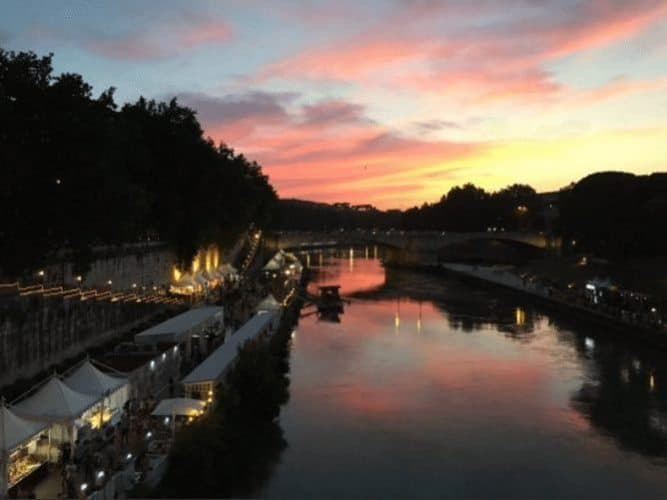
Rome’s famous neighborhood near the Colosseum
By Greg Roensch

I recently spent three weeks in Rome, in the cramped and cobbled district of Trastevere. Looking back on the trip, I find it was the sounds of this ancient district more than anything else that left a mark on me.
More than strolling through rustic alleys and polished palazzos. More than eating the world-renowned pasta and pizza. More than drinking the cheap but good vino rosso and demon grappa. And, yes, even more than sampling my fair share of gelato at any and every opportunity.
Dissecting the Sonic Recipe

The sound of Trastevere is a sonic brew comprised of many ingredients. Some of the sounds are loud like a cannon blast. Some are quiet like a pigeon roosting on the roof.
Some of the sounds are spontaneous, like a mob of students breaking into song, and some are metronome-steady like the bells of Santa Maria in Trastevere.
It’s never quiet for long in Trastevere. The noise builds gradually throughout the morning. By 9 AM, you’re likely to have already heard the crash of bottles into recycling bins, the buzz and grind of power tools, and the “Ciao, ciao, ciao” of people on their way to the café for an eye-popping jolt of espresso.
Numerous vehicles also contribute to the mix. Garbage trucks make their rounds, while motorcycles and scooters whine through the narrow streets. And so-called Smart Cars navigate the medieval maze with drivers who are sometimes smart and sometimes not.
If I were president for the day, I’d declare the whole area a pedestrian-only zone, but apparently, that’s not the Roman way.

At times, something truly unexpected is added to the sound of Trastevere. I happened to be visiting during an Italian national holiday (the Festa Della Republica), and as part of the festivities fighter jets rip-roared over the city’s historical center for practice runs during the days leading up to the big celebration.
On the day of the official fly-over, they released streams of green, white, and red smoke in their wake before disappearing into the wild blue yonder. Viva Italia.
A Festival of Birds
You might be surprised to learn that there’s an abundance of birdlife in Rome. I’m no ornithologist, but I can attest to the fact that birds add significantly to the Trastevere soundscape.
We have the daredevil swifts, aerial acrobats of the highest order. They zip across the sky at breakneck speeds with absolute precision.
On the other end of the bird-spotting spectrum, you can see the slothful pigeon. I’ve heard that all creatures serve a purpose in this world. Someone needs to tell me how the pigeon fits into such a scheme. Are these winged vermin necessary? Really, are they?

Case in point, we spent a few days in Venice and saw countless people on Piazza San Marco attempting to lure pigeons to eat out of their hands, off their arms, and even off the top of their heads.
Is this the pigeon’s raison d’être? To provide some strange form of entertainment to tourists? Someone tell me, please
Meanwhile, back in Trastevere, we come to the loudest of our aviary bunch: the gull. While the Roman variety might look like their California counterparts, they certainly don’t sound anything like the birds I’m familiar with back home in San Francisco.
These Italian gulls are the perpetrators of the most heinous, blood-curdling, fingernails-on-blackboard kind of shriek imaginable. They screech and it sounds like they’re dying of thirst.
I notice the gulls most in the early morning. That is, when Trastevere is at its most peaceful, the neighborhood as quiet as can be. This is the time when the gulls have chosen to unleash their parched-throat howl.
High Noon in Trastevere

Each day at noon a cannon is fired from the Janiculum hill overlooking Trastevere. I’m sure there’s some historical significance for the blast, though I haven’t taken the time to figure out what it is.
Perhaps it serves as a tribute to an ancient victory or maybe it all started as a warning shot to keep potential marauders on their toes. Like the Huns, or the Visogoths, or those Anglo-Saxon dogs. Or something like that.
Whatever the case may be, I know one thing for certain about the cannon. Though it is fired every day at noon like clockwork, the blast made me jump out of my skin every time.
Apparently, the neighborhood birds haven’t gotten used to explosion either. The noise inevitably sent them into one of their terrible squawking frenzies.
By noontime, the waiters of Trastevere are already casting half-hearted “Buon Giornos” at the passing tourists to entice them into their dens of culinary delight. Tourists, for their part, roam the streets like a herd of cattle looking for the next patch of grass. The locals won’t be eating for another ninety minutes or so, but the tourists need to be fed.
As the lunch crowd settles in, I hear the banter of waiters, the multilingual layers of chatter of the restaurant goers, and the clatter of plates, glasses, and utensils. The din indicates that people are enjoying the food and drink and each other’s company. They are enjoying life in general in Trastevere.
Revelry into the Wee Hours
There’s somewhat of a lull after lunch. Then, as evening comes, the sound builds again. The waiters serve a new wave of hungry tourists first. When the Italians arrive for dinner around 9 PM, the scene really swings into life.
The crowd becomes more festive and louder, clinking glasses and inevitably breaking into song. It’s also not uncommon during the evening to hear a wandering accordionist play “My Way” or “Volare” or some other tried-and-true tourist standard. Just once I’d like to hear Led Zeppelin or Metallica. Please.
The revelry will last until 3 AM or thereabouts, at which point the restaurants and bars will have finally shut their metal gates and doors with a clang, the partygoers will have stumbled along on their merry way, and the birds will descend once again to scavenge for grub and shriek to the high heavens.
Thinking again about the noontime cannon blast, maybe it serves more of a practical purpose than I’d imagined. Maybe it’s really a neighborhood alarm clock, a signal to Trastevere to wake up and do it all over again.

Greg Roensch owns and operates a one-man editorial service company, Six String Communications . When not writing and editing for work, he writes short stories, composes quirky pop songs, and likes to travel.
- These 9 U.S. National Parks Require Reservations in 2024 - April 17, 2024
- Take a Hike in Olympic National Park - April 17, 2024
- The Wild Mississippi: 2340 Miles Across Ten States - April 8, 2024

